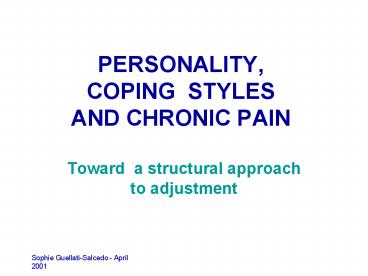PERSONALITY, COPING STYLES AND CHRONIC PAIN - PowerPoint PPT Presentation
1 / 41
Title:
PERSONALITY, COPING STYLES AND CHRONIC PAIN
Description:
the definition of concepts. the operationalization of variables ... The relationship between usual patterns of behavior and specific pain-related ... – PowerPoint PPT presentation
Number of Views:229
Avg rating:3.0/5.0
Title: PERSONALITY, COPING STYLES AND CHRONIC PAIN
1
PERSONALITY,COPING STYLES AND CHRONIC PAIN
- Toward a structural approach to adjustment
2
Outline
- 1. Introduction
- 2. Goal
- 3. Definitions
- 4. Hypotheses
- 5. Sample and Measures
- 6. Results
- 7. Conclusion
3
Outline
- 1. Introduction
- 2. Goal
- 3. Definitions
- 4. Hypotheses
- 5. Sample and Measures
- 6. Results
- 7. Conclusion
4
1.1. The biopsychosocial model of pain
- The Gate Control Theory
- Melzack Wall (1965)
- Multidimensional model of pain
- 4 components sensory-discriminative
- affective-emotional
- cognitive
- behavioral
- Definition of the IASP
5
1.2. Models of Personality
- Trait ? State Model
- (Cottraux Blackburn, 1995)
- Big Five Model (Digman, 1990)
- The Five-Factor Theory
- (McAdams, 1996 Costa McCrae, 1999)
6
1.3. Coping and correlates
- Dispositional vs. Situational approach
- Coping styles vs. Coping responses
- Regulating role vs. Outcomes
- Adjustment vs. Adaptation
7
1.4. Model proposed
- Structural approach
- Postulate Regularities in behavior
- Type of relationship between variables
- A three-level hierarchical model
8
Outline
- 1. Introduction
- 2. Goal
- 3. Definitions
- 4. Hypotheses
- 5. Sample and Measures
- 6. Results
- 7. Conclusion
9
2. Goal
- Answer this question
- Does taking into consideration usual patterns of
cognition and behavior allow a better
understanding of specific cognitive-behavioral
responses to the experience of chronic pain ?
10
Outline
- 1. Introduction
- 2. Goal
- 3. Definitions
- 4. Hypotheses
- 5. Sample and Measures
- 6. Results
- 7. Conclusion
11
3. Definitions
- A theoretical position constrains
- the definition of concepts
- the operationalization of variables
12
3.1. Usual patterns of behavior
- Three levels of patterns
- personality dimensions (Big Five)
- coping styles
- usual coping responses to pain
- characterized by
- temporal stability
- cross-situational consistency
13
3.2. Components of adjustment
- Sensory component of pain
- Sensory / affective descriptors
- Functional component Impact on everyday
life - Emotional component
- Depressive / Anxious states
14
Outline
- 1. Introduction
- 2. Goal
- 3. Definitions
- 4. Hypotheses
- 5. Sample and Measures
- 6. Results
- 7. Conclusion
15
4.1. Main Hypothesis
- Chronic pain patients adopt specific pain-related
behaviors that depend on their personality traits
and coping styles - The components of their adjustment to pain
are related to their usual patterns of behavior
16
4.2. Operationalization
- The relationship between usual patterns of
behavior and specific pain-related adjustment
responses differs according to the aspect of pain
experience measured - intensity and description of pain
- functional status (daily activities)
- emotional state (depression, anxiety)
17
Outline
- 1. Introduction
- 2. Goal
- 3. Definitions
- 4. Hypotheses
- 5. Sample and Measures
- 6. Results
- 7. Conclusion
18
5.1. Population and Sample
- Outpatients from a multidisciplinary pain clinic
- A specific category of pain patients
- An heterogeneous sample.
- Random diversity of pathologies
- Average duration of pain 7.8 years
19
5.2. Measures of usual patterns of
behavior
- 3 degrees of predictors
- Personality traits
- Coping styles
- Coping responses to pain
- D5D
- CISS
- CSQ
20
5.3. Measures of pain adjustment
- 4 categories of outcome variables
- Intensity of pain
- Description of pain
- Functional impact
- Emotional impact
21
Outline
- 1. Introduction
- 2. Goal
- 3. Definitions
- 4. Hypotheses
- 5. Sample and Measures
- 6. Results
- 7. Conclusion
22
6.1. Proportions of variance
explained
- Sensory components
- intensity of pain 21
- description of pain 41
- Functional impact
- daily activities 30
- outdoor and social activities 44
- Emotional impact
- Depressive state 53
- Anxious state 52
23
6.3. Prediction of pain intensity
Proportion of variance explained
D5D
24
6.2. Partial Correlations
25
6.4. Prediction of affective
description of pain
Proportion of variance explained
D5D
26
6.2. Partial Correlations
27
6.5. Prediction of functional impact of
pain On everyday life
Proportion of variance explained
D5D
28
6.5. Prediction of functional impact of
pain On household chores
Proportion of variance explained
D5D
29
6.2. Partial correlations
30
6.5. Prediction of functional impact of
pain On outdoor and social activities
Proportion of variance explained
D5D
31
6.2. Partial correlations
32
6.6. Prediction of emotional impact of
pain Depressive state (BDI 13)
Proportion of variance explained
D5D
33
6.2. Partial correlations
34
6.6. Prediction of emotional impact of
pain Depressive state (HAD Depression)
Proportion of variance explained
D5D
35
6.6. Prediction of emotional impact of
pain Anxious state (HAD Anxiety)
Proportion of variance explained
D5D
36
6.2. Partial correlations
37
Outline
- 1. Introduction
- 2. Goal
- 3. Definitions
- 4. Hypotheses
- 5. Sample and Measures
- 6. Results
- 7. Conclusion
38
7. Conclusion
- Usual patterns of behavior
- distal variables personality
- proximal variables coping
- ? are significantly correlated with the
components of pain adjustment - ? Different patterns of predictors with different
aspects of adjustment
39
7. Conclusion Personality Dimensions
- Neuroticism is associated
- with poorer adjustment to pain
- Emotional stability, openness, and
conscientiousness are associated - with better adjustment to pain
40
7. Conclusion Coping Styles
- Emotion-oriented coping is associated with poorer
adjustment to pain - Task-oriented coping and avoidance are associated
with better adjustment to pain
41
7. Conclusion Coping responses to pain
- Catastrophizing, praying and hoping, and
distraction are associated with poorer adjustment
to pain - Coping self-statements and reinterpreting
sensations are associated with better adjustment
to pain

